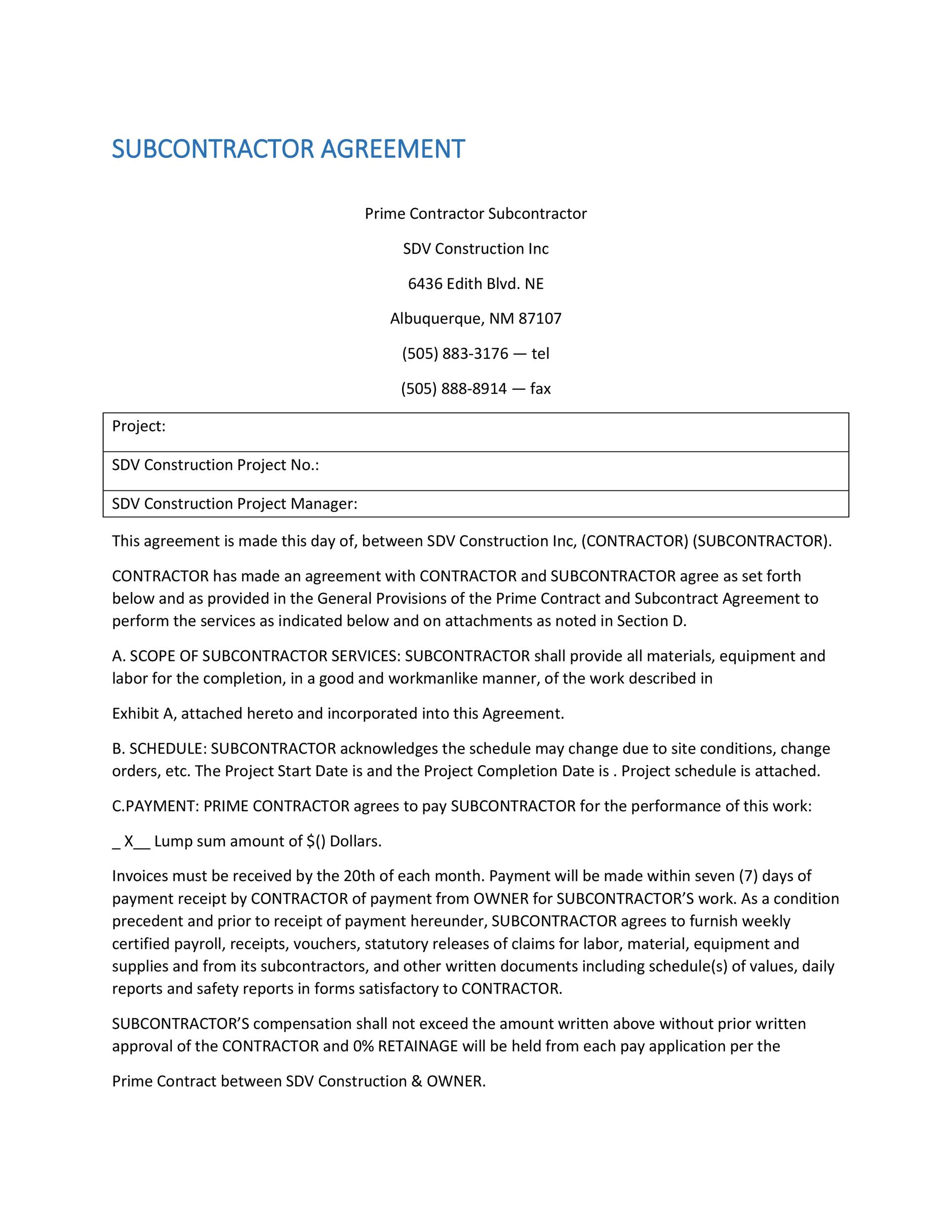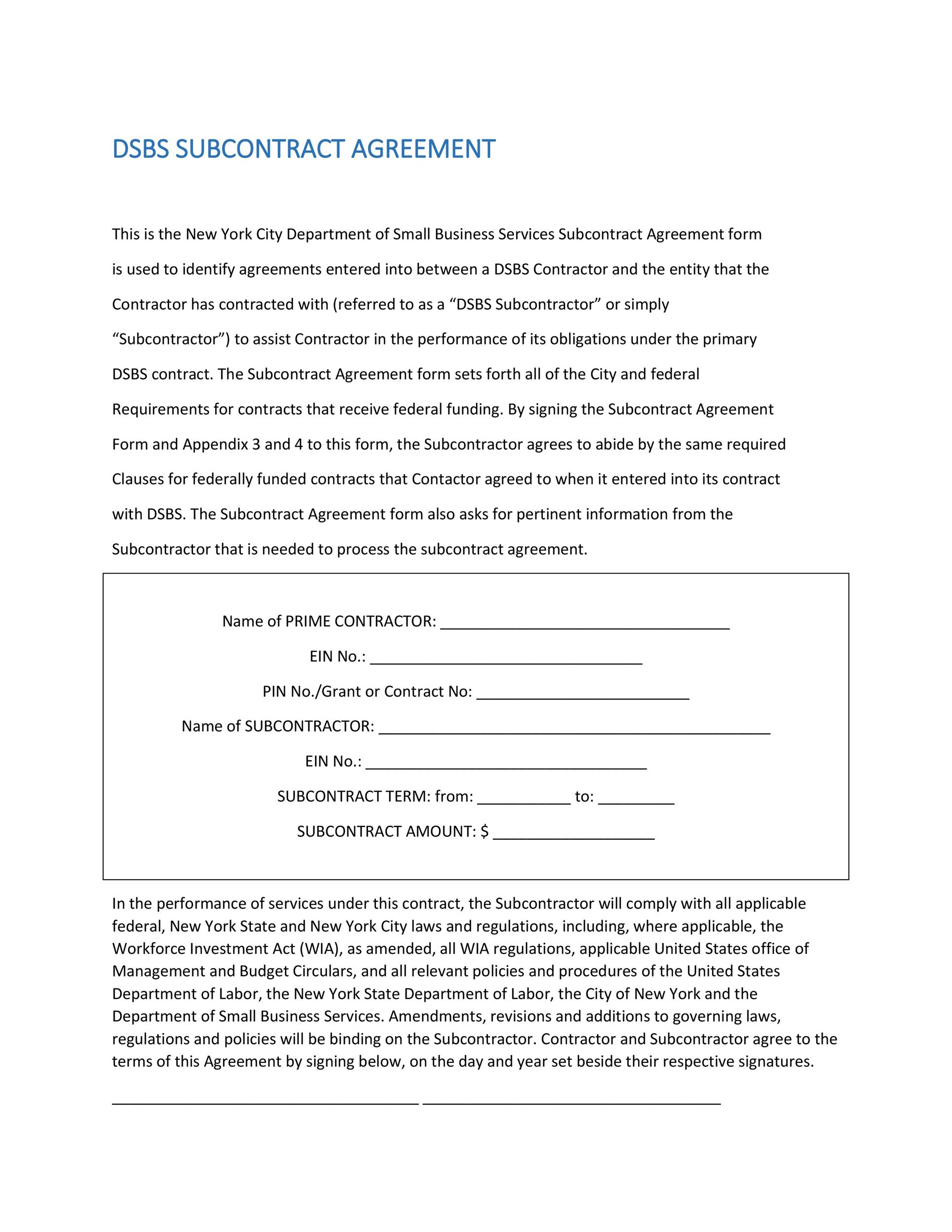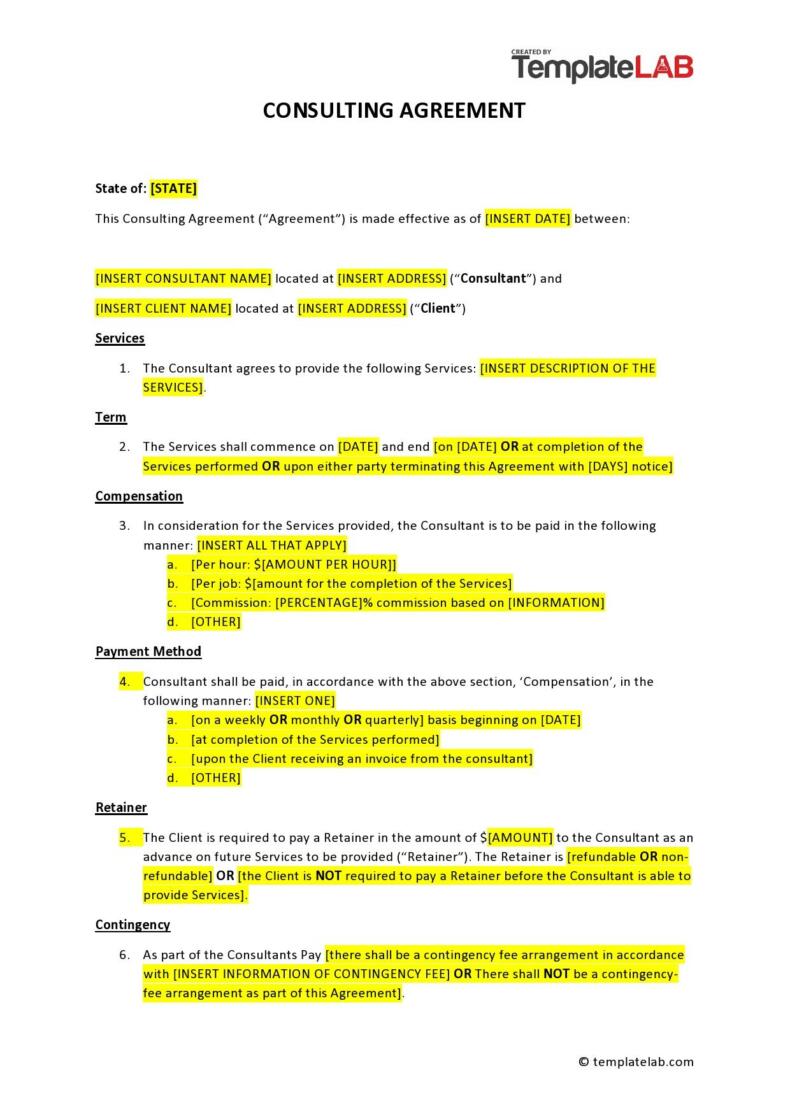A subcontractor agreement is an important legal document defining the terms of a business-related agreement between a contractor and a subcontractor. Since a subcontractor agreement requires specific information relating the terms of the agreement in clear, concise and legally-applicable language, you’ll want a professional form to have on hand to create a document with legally-binding ramifications if one or both parties breach the agreement.
Table of Contents
- 1 Subcontractor Agreement Templates
- 2 Gathering information for the form
- 3 Who needs a subcontractor agreement form?
- 4 Subcontractor Agreement Samples
- 5 What are the necessary subcontractor agreement clauses?
- 5.1 Scope of the Project
- 5.2 Timing for Completion: “Duration of Work Clause.”
- 5.3 Payment and Billing Clause
- 5.4 Independent Contractor Notice
- 5.5 Non-Disclosure Agreement
- 5.6 Non-Complete Clause
- 5.7 Work for Hire Inclusion
- 5.8 Responsibilities for Insurance for Accidental Damages
- 5.9 Assignment Restrictions and Permissions
- 5.10 Indemnity Clause
- 5.11 Warranties
- 6 Subcontractor Agreement Format
- 7 Final words
The document has various sections and inclusions. You can benefit from using a professional subcontractor agreement template as it contains all the necessary areas you’ll have to document as you create the contract. If you choose to forego hiring a legal professional to work out all the details of a subcontractor agreement, the use of a formal, pre-made subcontractor agreement template is the next best thing. You can make sure you include all details relating to the contract in a form that will still be legally binding. The benefits of using a template include potential money-savings in terms of legal fees and document creation. The bigger benefit, however, is the legal protections the document provides to the contractor(s) and subcontractor(s) mentioned in the subcontractor agreement form.
The Internal Revenue Service has a concise definition of what a subcontractor is and who can use the title. Per the IRS, a subcontractor is the same thing as an independent contractor. The subcontractor does work for other people, businesses, and contractors, but is not a direct employee of any of the latter. The subcontractor is self-employed and tracks their own income and expenses. The subcontractor is also responsible for handling the payment of all IRS taxes through self-employment tax payments. The contractor working with the subcontractor is not responsible for the subcontractor’s taxes, income tracking, or providing insurance for the subcontractor. When a contractor, business, or individual needs assistance or the skills of someone who can help them complete a project, they can parcel out the work to a subcontractor for completion.
Subcontractor Agreement Templates
Gathering information for the form
There are a few things a contractor needs to consider before entering into a subcontractor agreement with another. First, the contractor needs to find out if the client is willing to allow for subcontracted work. When a contractor makes an agreement to complete a project for a client, the contractor and client enter into a contractual agreement. The agreement is called a Master Agreement. Within that master agreement, there will be an indication if the client agrees to allow the contractor to subcontract out any part of the project. If this is not included in the document, it should be assumed the client does not want anyone other than the original contractor to complete the work. If the Master Agreement restricts the contractor from hiring subcontractors, the contractor is bound legally to uphold the terms on the Master Agreement.
The Master Agreement needs to have unique language in it describing the responsibilities and duties of contractors and subcontractors. The contracting party will need to be held harmless in relation to any mistakes or damage that arises from a subcontractor’s work. If this legal language is missing from the document, the contractor might be stuck paying for damages or mistakes.
Who needs a subcontractor agreement form?
The subcontractor template makes legal document creation easy. The document is simple to fill out because the necessary clauses are already present in the text. The contractor can define the terms of the agreement to clarify who is responsible for what work, and what the scope of the work includes. It’s imperative that the document includes clear language to keep all parties agreeing to the terms legally protected. Parties that benefit from using a subcontractor agreement form include:
- Commercial Property Owners
- Construction Contractors
- Contractors
- Corporations
- Ecommerce Operators
- Entrepreneurs and Sole Properties
- Home Owners
- Independent Contractors Hiring Other Subcontractors
- Individuals Seeking to Hire Subcontractors
- Lawyers
- Limited Liability Corporations
- Small Business Owners
Subcontractor Agreement Samples
What are the necessary subcontractor agreement clauses?
The subcontractor template will contain numerous clauses. Each section is written in concise language. The clarity of the terms is vital so ambiguities or confusion does not occur in the future. The clarity of the document ensures legal protections for all the parties agreeing to the expressed terms.
Scope of the Project
This section of the subcontractor agreement defines the project and the work necessary. The client’s demands are an inclusion. The subcontractor’s responsibilities as well as what the hiring contractor expects are inclusions in the Scope of the Work clause. If you are reviewing the section, it will contain information in relation to “what if” scenarios. For instance, if an eCommerce site operator hires a contractor who subcontracts some of the graphic designs, the subcontractor agreement form will include information in relation to client expectations. More importantly, it will also have telling information about subcontractor obligations if the client is dissatisfied with the work, needs changes, or wants alterations.
The project might have a title or reference: This is part of the Scope of the Work details. It will list the project owner. The location of the project or project owner is something appearing in this section of the form.
Timing for Completion: “Duration of Work Clause.”
When creating the subcontractor agreement form, the contractor should add additional time for the contractors to complete the work. Defining a loose timeline allows the contractor to make clear expectations without overstepping the boundaries the Internal Revenue Service puts in its definitions between an employer and a contract. This area of the agreement might include things like a fixed time deadline, but the minute by minute or hour by hour write up is a bit too specific given the nature of the subcontractor’s and contractor’s role. Including a deadline that falls well before the contractor’s final deadline also ensures the contractor gets plenty of time to assess the work the subcontractor performers. Quality assurances will ease the mind of the client and main contractor.
Payment and Billing Clause
The subcontractor agreement template will include a clause section for defining the payments the subcontractor will receive. Payments are based on the scope of the work. If more time to complete the work is something that’s required, the contract will include information about the additional payment. Hourly, weekly, biweekly, or monthly payment information will be included in this area of the contractual form. Additional details include:
- Maximum work hours each week or month.
- Subcontractor payment milestones.
- The expected timing of invoices.
- What happens in there is more time needed and the fixed price doesn’t cover the added time.
- Whether the project has a fixed price or flexible payment option.
Independent Contractor Notice
It might seem obvious when you are using a subcontractor agreement that you are hiring an independent contractor to do work. Obvious or not, legal protection is better in writing. A clause here allows you to identify the subcontractor and to make a note of the responsibility the subcontractor must handle tax deductions and payments. This section should mention the subcontractor’s responsibilities to handle all the following:
- Insurance (The contractor does not provide worker’s compensation insurance for subcontractors)
- IRS tax withholdings
- The subcontractor’s required provision of a W9 to the contractor.
- The contractor’s required provision of a 1099 form at year’s end for the subcontractor’s tax filing purposes.
- Self-employment tax payments being the responsibility of the subcontractor.
- The absence of any promise to pay for profit sharing, pension, paid holidays, paid vacations, insurance, unemployment compensation or any other employment benefits.
- The responsibility of the subcontractor to pay for Social Security benefits.
- The subcontractor’s responsibilities for providing health insurance.
Non-Disclosure Agreement
The Non-disclosure agreement is a section defining the information the contractor and/or subcontractor must keep confidential. If the project details are something that cannot be shared or discussed, this needs to be included in the subcontractor template. Here the contractor will need to review the Master Agreement to ensure there is not a conflict between sharing information with the subcontractor. The non-disclosure agreement must define, but not conflict with, any confidentiality terms already mentioned in the contractor’s Master Agreement with the hiring client. If confidentiality rules are in any way violated, this section of the subcontractor’s form defines the consequences of the violation.
Non-Complete Clause
This section of the contract ensures the contractor doesn’t violate any local laws in relation to competing with the contractor. It is an important part of the subcontractor contract template because it prevents the subcontractor from taking unethical actions to steal clientele or work from the hiring contractor. This clause prevents the act of undermining the hiring contractor by offering lower bids or talking to hiring clients to gain their business. The section defines what happens if the subcontractor violates the non-disclosure.
Work for Hire Inclusion
This section ensures that all work belongs to the hiring contractor or individual. It makes clear the contractor gets a set pay for the work. Then the rights to any of the work has been signed over. The contractor or hiring entity is the permanent owner of the project. No future income goes to the contractor in relation to the project, should it generate and income in the future in the way of sales or royalties.
Responsibilities for Insurance for Accidental Damages
The contractor may or may not have insurance that covers a subcontractor’s mistakes, errors, or any accidental damage the subcontractor might cause. If the contractor has insurance it needs to be mentioned here. If the contractor does not, the Insurance clause needs to make clear the client’s insurance responsibilities. The demand for proof of coverage via the presentation of an insurance certificate should be noted in this area as well. A demand for coverage under the subcontractor’s basic liability policy will cover both subcontractor and contractor in the case certain damages arise. The kinds of insurance and the coverage available that need to be listed in the subcontractor form include: things like Commercial General Liability Coverage and Errors and Omission Insurance.
Assignment Restrictions and Permissions
This section of the subcontractor contract template allows the contractor to define certain permissions and restrictions the subcontractor has in relation to hiring others to do work. The contractor often puts limits on the subcontractor to prevent the line of work responsibilities from being spread too thin. With too many hands in the work, problems can arise and cause the contractor to lose control of the project and its successful completion.
Indemnity Clause
This part of the contract ensures protections for the contractor. When the project is complete if something goes wrong that was the responsibility of a subcontractor, then the contract will have a means of recovering any losses. If the error is something the contractor is responsible for, the subcontractor is not held responsible and the contractor has no legal means of collection. The laws of the state where the work is performed will need to be referenced here, since some states have certain restrictions in relation to indemnification clause inclusions. Some states disallow the claim on indemnity if the problem is due to willful misconduct or negligence. The subcontractor template will include this section, but the contractor should do a bit of legal research and fact checking to cover all bases. The wording of the section needs to be accurate and precise, all while adhering to the legal limitations indicated by state laws.
Warranties
This section must include any promises the contractor makes to the subcontractor and vice versa. Some of the typical inclusions you will find in a subcontractor form include any of the following terms:
- A guarantee of work quality.
- A guarantee the subcontractor has the tools, ability, knowledge, and skill to complete the work necessary.
- A guarantee to meet the specifications of the project.
- A guarantee to repair any issues with any deliverables, inconsistent work, or project defects.
- A warrantee ensuring professional work behavior.
- The promise of original, uncompromised work that does not infringe on the rights of another’s property or work.
Subcontractor Agreement Format
Final words
The subcontractor agreement is a complex document covering the expectations of a hired subcontractor. It also covers the obligations a hiring contractor must meet when entering into an agreement with a subcontractor. The parties and their contact information are just the most basic of information this important form contains. Without the use of a subcontractor agreement template, it is possible to miss an important clause inclusion that can protect the one or more parities that have entered into the agreement. With the legal protections the document provides, taking the time to fill one out with care is just good business sense.














































